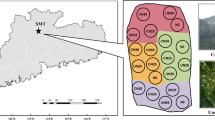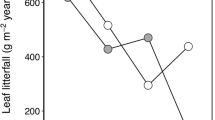Abstract
Silicon uptake by terrestrial plants impacts the Si land-ocean fluxes, therefore inducing significant modifications for biogeochemical cycle of Si. Understanding the mechanisms that control Si uptakes by forest vegetation is of great interest for the study of the global Si cycle as the world’s total forest area corresponds to about 30% of the land area. Our study compares Si uptake in controlled conditions by two coniferous species (Pseudotsuga menziensii and Pinus nigra) exhibiting contrasting Si uptake in the field. For this purpose, seedlings were grown for 11 weeks under controlled conditions in hydroponics with different Si concentrations (0.2 to 1.6 mM) in nutrient solutions. The Si concentrations were greater in Douglas fir leaves as compared with Black pine leaves and increased, depending on the Si concentration in the nutrient solution. According to mass balance, Si absorption seems to have been driven by passive Si transport at 0.2 mM Si (realistic concentration for forest soil solutions) and was rejective at higher Si concentrations in nutrient solution for both species. For this reason, we attributed the higher Si concentration in Douglas fir leaves to the greater cumulative transpiration of these seedlings. We suggest that contrasting transpiration rates may also play a key role in controlling Si accumulation in leaves at field scale.




Similar content being viewed by others
References
Bartoli F (1983) The biogeochemical cycle of silicon in two temperate forest ecosystems. Ecol Bull 35:469–476
Bartoli F, Souchier B (1978) Cycle et rôle du silicium d’origine végétale dans les écosystèmes forestiers tempérés. Ann Sci forest 35:187–202
Bélanger RR, Bowen PA, Ehret DL, Menzies JG (1995) Soluble silicon: its role in crop and disease management of greenhouse crops. Plant Disease 79:329–336
Berner RA (1997) The rise of plants and their effect on weathering and atmospheric CO2. Science 276:544–546
Breda N, Soudani K, Bergonzini JC (2002) Mesure de l’indice foliaire en forêt. Doc GIP ECOFOR Paris Laballery, Clamecy imp, p 157
Casey WH, Kinrade SD, Knight CTG, Rains DW, Epstein E (2003) Aqueous silicate complexes in wheat, Triticum aestivum L. Plant Cell Environ 27:51–54
Chao TT, Sanzolone RF (1992) Decomposition techniques. J Geochem Explor 44:65–106
Conley DJ (2002) Terrestrial ecosystems and the global biogeochemical silica cycle. Global Biogeochem Cycles 16:1121–1128
Conley DJ, Schelske CL, Stoermer EF (1993) Modification of silica biogeochemistry with eutrophication in aquatic systems. Mar Ecol Prog Ser 101:179–192
Conley DJ, Likens GE, Buso DC, Saccone L, Bailey SW, Johnson CE (2008) Deforestation causes increased dissolved silicate losses in the Hubbard Brook Experimental Forest. Glob Change Biol 14:2548–2554
Cornelis JT, Ranger J, Iserentant A, Delvaux B (2010) Tree species impact the terrestrial cycle of silicon through various uptakes. Biogeochemistry 97:231–245
Derry LA, Kurtz AC, Ziegler K, Chadwick OA (2005) Biological control of terrestrial silica cycling and export fluxes to watersheds. Nature 433:728–731
Drees LR, Wilding LP, Smeck NE, Sankayi AL (1989) Silica in soils: quartz and disordered silica polymorphs. In: Dixon JB, Weed SB (eds) Minerals in soil environments. Soil Science Society of America Book Series No. 1, Madison, pp 913–974
Emadian SF, Newton RJ (1989) Growth enhancement of loblolly pine (Pinus taeda L.) seedlings by silicon. J Plant Physiol 134:98–103
Epstein E (1994) The Anomaly of silicon in plant biology. Proc Natl Acad Sci USA 91:11–17
Epstein E (1999) Silicon. Annu Rev Plant Phys 50:641–664
Fraysse F, Pokrovsky OS, Schott J, Meunier JD (2009) Surface chemistry and reactivity of plant phytoliths in aqueous solutions. Chem Geol 258:197–206
Fulweiler RW, Nixon SW (2005) Terrestrial vegetation and the seasonal cycle of dissolved silica in a Southern New England coastal river. Biogeochemistry 74:115–130
Gérard F, François M, Ranger J (2002) Processes controlling silica concentration in leaching and capillary soil solutions of an acidic brown forest soil (Rhône, France). Geoderma 107:197–226
Gérard F, Mayer KU, Hodson MJ, Ranger J (2008) Modelling the biogeochemical cycle of silicon in soils: application to a temperate forest ecosystem. Geochim Cosmochim Acta 72:741–758
Henriet C, Draye X, Oppitz I, Swennen R, Delvaux B (2006) Effects, distribution and uptake of silicon in banana (Musa spp.) under controlled conditions. Plant Soil 287:359–374
Hodson MJ, Sangster AG (1999) Aluminium/silicon interactions in conifers. J Inorg Biochem 76:89–98
Hodson MJ, White PJ, Mead A, Broadley MR (2005) Phylogenetic variation in the silicon composition of plants. Ann Bot 96:1027–1046
Ingestad T (1971) A definition of optimum nutrient requirements in birch seedlings. II. Physiol Plant 24:118–125
Jones LHP, Handreck KA (1965) Studies of silica in the oat plant. III. Uptake of silica from soils by plant. Plant Soil 23:79–96
Jones LHP, Handreck KA (1967) Silica in soils, plants, and animals. Adv Agron 19:107–149
Klein RL, Geis JW (1978) Biogenic silica in the Pinaceae. Soil Sci 126:145–156
Korndörfer GH, Lepsch I (2001) Effect of silicon on plant growth and crop yield. In: Datnoff LE, Snyder GH, Korndörfer GH (eds) Silicon in agriculture. Elsevier, The Netherlands, pp 133–147
Liang YC, Hua HX, Zhu YG, Zhang J, Cheng CM, Römheld V (2006) Importance of plant species and external silicon concentration to active silicon uptake and transport. New Phytol 172:63–72
Liang YC, Sun WC, Zhu YG, Christie P (2007) Mechanisms of silicon- mediated alleviation of abiotic stresses in higher plants: A review. Environ Pollut 147:422–428
Ma JF (2004) Role of silicon in enhancing the resistance of plants to biotic and abiotic stresses. Soil Sci Plant Nutr 50:11–18
Ma JF, Takahashi E (2002) Soil, fertilizer and plant silicon research in Japan. Elsevier, The Nederlands, p 281
Ma JF, Yamaji N (2006) Silicon uptake and accumulation in higher plants. Trends Plant Sci 11:392–397
Ma JF, Tamai K, Yamaji N, Mitani N, Konishi S, Katsuhara M, Ishiguro M, Murata Y, Yano M (2006) A silicon transporter in rice. Nature 440:688–691
Ma JF, Yamaji N, Mitani N, Tamai K, Konishi S, Fujiwara T, Katsuhara M, Yano M (2007) An efflux transporter of silicon in rice. Nature 448:209–212
Markewitz D, Richter D (1998) The bio in aluminium and silicon geochemistry. Biogeochemistry 42:235–252
Mitani N, Ma JF (2005) Uptake system of silicon in different plant species. J Exp Bot 56:1255–1261
Nikolic M, Nikolic N, Liang YC, Kirkby EA, Römheld V (2007) Germanium-68 as an adequate tracer for silicon transport in plants: Characterization of silicon uptake in different crop species. Plant Physiol 143:495–503
Richmond KE, Sussman M (2003) Got silicon? The non-essential beneficial plant nutrient. Curr Opin Plant Biol 6:268–272
Saccone L, Conley DJ, Koning E, Sauer D, Sommer M, Kaczorek D, Blecker SW, Kelly EF (2007) Assessing the extraction and quantification of amorphous silica in soils of forest and grassland ecosystems. Eur J Soil Sci 58:1446–1459
Sangster AG, Ling L, Gérard F, Hodson MJ (2007) X-ray microanalysis of needles from Douglas fir growing in environments of contrasting acidity. Water Air Soil Pollut 7:143–149
Stumm W, Morgan JJ (1996) Aquatic chemistry-chemical equilibria and rates in natural waters. Wiley, New York, p 1022
Takahashi E, Ma JF, Miyake Y (1990) The possibility of silicon as an essential element for higher plants. Comments Agric Food Chem 2:99–122
Tréguer P, Nelson DM, Van Bennekom AJ, De Master DJ, Leynaert A, Quéguiner B (1995) The silica balance in the world ocean: a reestimate. Science 268:375–379
Yamaji N, Mitani N, Ma JF (2008) A transporter regulating silicon distribution in rice shoots. Plant Cell 20:1381–1389
Acknowledgements
Our special thanks to P. Populaire and Pr. J. Dufey (UCL) for technical support and advice. We also thank A. Iserentant (UCL) for ICP-AES analysis, M. Jonard (UCL), P. Lhoir (UCL), J.-P. Misson (Gembloux) and A. Servais (“Nature and Forest Department”, Marche-en-Famenne) for fruitful discussion and seed acquisition. J.T. Cornelis is sponsored by the Fonds pour la formation à la Recherche dans l’Industrie et dans l’Agriculture (FRIA) of Belgium. This research was sponsored by the UCL Fonds Spécial de Recherche (FSR) 2008.
Author information
Authors and Affiliations
Corresponding author
Additional information
Responsible Editor: Jian Feng Ma.
Rights and permissions
About this article
Cite this article
Cornelis, JT., Delvaux, B. & Titeux, H. Contrasting silicon uptakes by coniferous trees: a hydroponic experiment on young seedlings. Plant Soil 336, 99–106 (2010). https://doi.org/10.1007/s11104-010-0451-x
Received:
Accepted:
Published:
Issue Date:
DOI: https://doi.org/10.1007/s11104-010-0451-x




